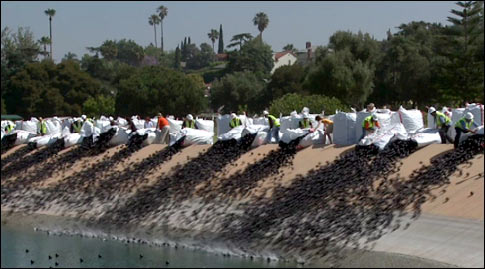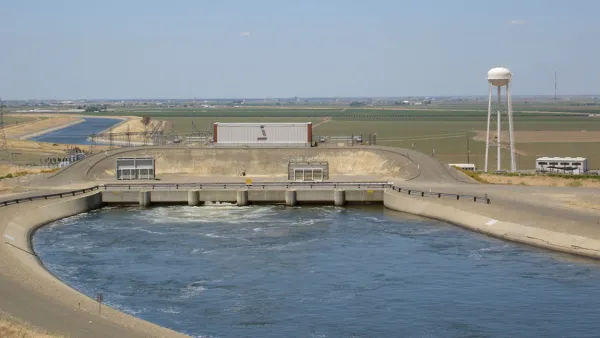Adaptation is a way of life. But we humans have been building our habitats and cities in pursuit of permanence. This is an unreachable goal. Making our cities and communities and lifestyles adapt to outside influences is typically an afterthought. We do tend to react, and we often react very effectively. But solving problems before they happen has never been a strong suit when it comes to urban development. This is especially true with regard to our impacts on the environment. A recent and bizarre example illustrates this point.
Adaptation is a way of life. But we humans have been building our habitats and cities in pursuit of permanence. This is an unreachable goal. Making our cities and communities and lifestyles adapt to outside influences is typically an afterthought. We do tend to react, and we often react very effectively. But solving problems before they happen has never been a strong suit when it comes to urban development. This is especially true with regard to our impacts on the environment. A recent and bizarre example illustrates this point.
The example revolves around water, and takes place in Los Angeles. The city is geographically a desert where water is naturally in low supply -- but because of the marvels of modern engineering and science it is now plentiful enough to meet the staggering demand of 4 million residents.
Reservoirs feed this demand for much of the city. These are big pools of water, often containing tens- to hundreds-of-millions of gallons of water. Like all those abandoned pools in the backyards of America's foreclosed suburban homes, reservoirs get kind of nasty unless they're treated. The chemical chlorine is the most common treatment.
Because water attracts life, bacteria forms in these reservoirs that can be harmful to people and other animals if ingested. So we've solved this potential problem by adding chlorine to the reservoirs. Another chemical that naturally exists in L.A.'s reservoir water is bromide. This is where the problem comes in.
In shorthand, bromide plus chlorine plus sunlight equals cancer.
When sun shines on the water, the chlorine used to keep it clean, and the bromide it contains, a carcinogen forms and effectively poisons the drinking water of hundreds of thousands of people.
But there is a solution: take sunlight out of the equation. Earlier this month the Los Angeles Department of Water and Power began a months-long process of "shading" reservoirs of concern. They're doing this by dropping millions of black-colored plastic balls into the reservoir. The balls are intended to float on the surface and block the sunlight from penetrating the water and causing the carcinogenic reaction.
Balls being dropped into L.A.'s Ivanhoe Reservoir. Click the picture to view a video from the Los Angeles Times.
Technically the problem is solved. It's an impressive and innovative solution, and one that makes for a great picture. But it stands as another reminder of the unintended consequences of human action. We had a need that nature didn't serve, so we created a solution. Our solution in turn created a problem. Now we've solved that problem, but what will follow?
We need water, and too many people in the Los Angeles desert rely on the reservoirs to get rid of them. We're stuck in what may end up being a long chain of problems responding to solutions responding to problems again and again.
Human ingenuity is truly amazing, and they way we can solve problems like this is encouraging for our future. But it also should make us pause for a moment and ask ourselves whether we want to keep living a life that continually needs a new bandage over the wound, a new finger in the levee crack, a new source for those most basic needs that keep us alive.
As our cities have faced a number of environmental challenges over the years, we've proven again and again that we can adapt after the fact. Now we need to focus on adapting our approach to development so that we won't need to enter the endless cycle of acting and reacting.

Analysis: Cybertruck Fatality Rate Far Exceeds That of Ford Pinto
The Tesla Cybertruck was recalled seven times last year.

National Parks Layoffs Will Cause Communities to Lose Billions
Thousands of essential park workers were laid off this week, just before the busy spring break season.

Retro-silient?: America’s First “Eco-burb,” The Woodlands Turns 50
A master-planned community north of Houston offers lessons on green infrastructure and resilient design, but falls short of its founder’s lofty affordability and walkability goals.

Test News Post 1
This is a summary

Analysis: Cybertruck Fatality Rate Far Exceeds That of Ford Pinto
The Tesla Cybertruck was recalled seven times last year.

Test News Headline 46
Test for the image on the front page.
Urban Design for Planners 1: Software Tools
This six-course series explores essential urban design concepts using open source software and equips planners with the tools they need to participate fully in the urban design process.
Planning for Universal Design
Learn the tools for implementing Universal Design in planning regulations.
EMC Planning Group, Inc.
Planetizen
Planetizen
Mpact (formerly Rail~Volution)
Great Falls Development Authority, Inc.
HUDs Office of Policy Development and Research
NYU Wagner Graduate School of Public Service





























